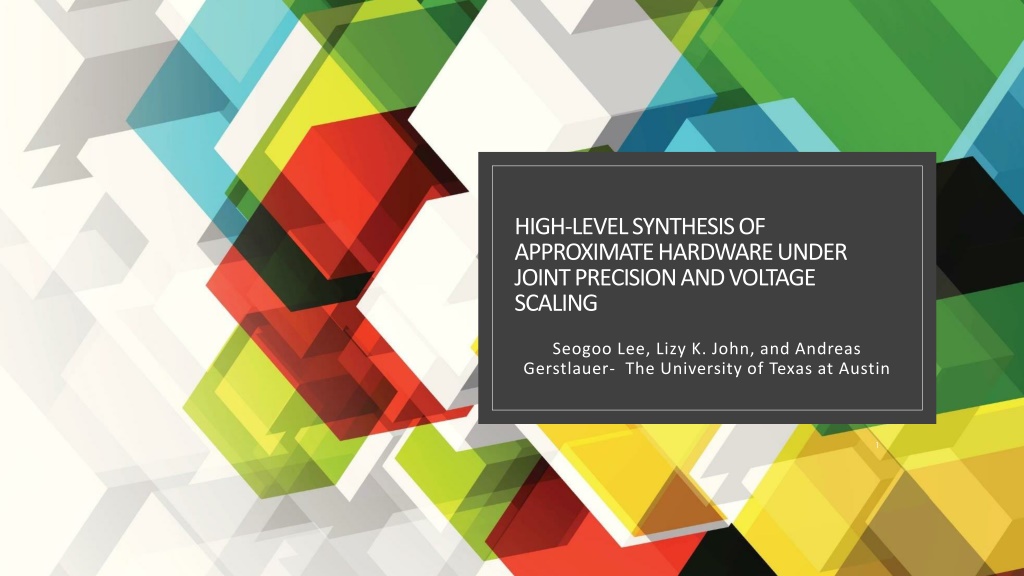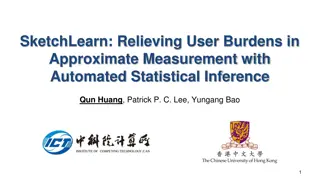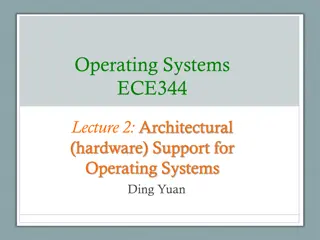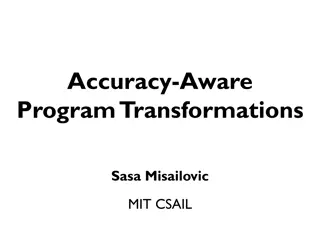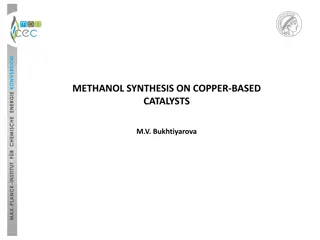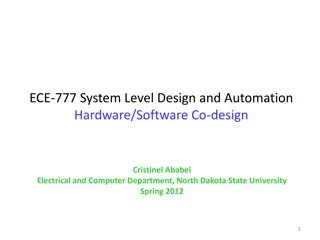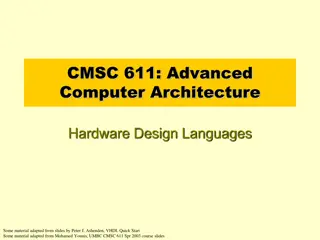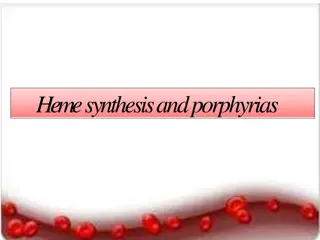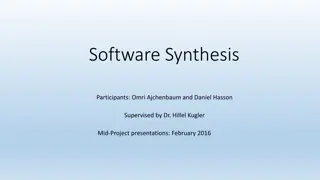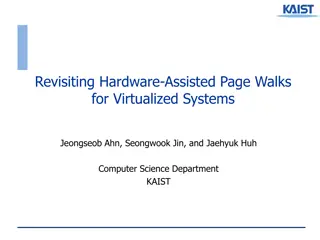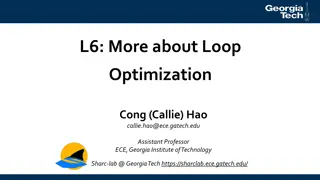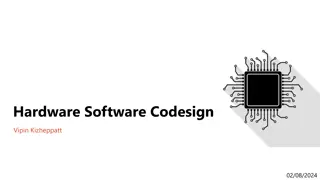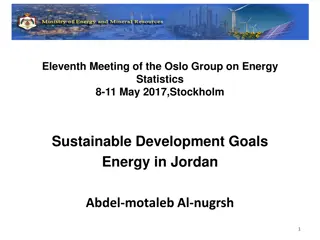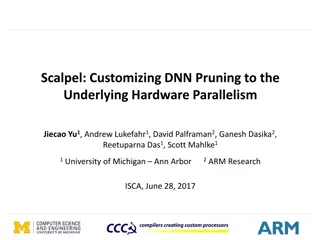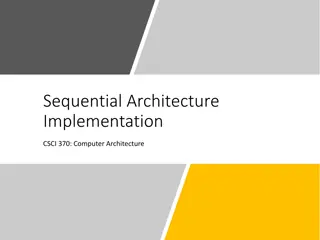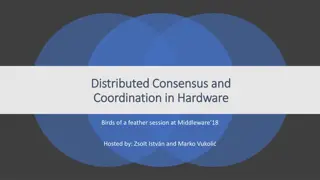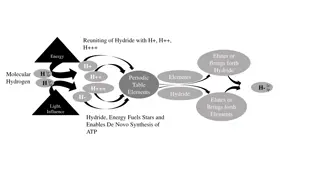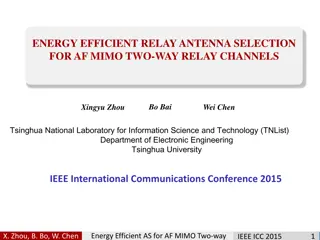Approximate Hardware Synthesis for Energy-Efficient Designs
The paper introduces an Approximate High-Level Synthesis (AHLS) approach for generating energy-optimized register-transfer-level hardware implementations from accurate high-level C descriptions. This approach considers joint precision and voltage scaling to maximize energy reductions while maintaining quality constraints. The proposed AHLS flow involves pre-processing steps, quality-energy optimization, and tight interaction with scheduling tasks to exploit scaling opportunities efficiently.
Download Presentation

Please find below an Image/Link to download the presentation.
The content on the website is provided AS IS for your information and personal use only. It may not be sold, licensed, or shared on other websites without obtaining consent from the author. Download presentation by click this link. If you encounter any issues during the download, it is possible that the publisher has removed the file from their server.
E N D
Presentation Transcript
HIGH-LEVEL SYNTHESIS OF APPROXIMATE HARDWARE UNDER JOINT PRECISION AND VOLTAGE SCALING Seogoo Lee, Lizy K. John, and Andreas Gerstlauer- The University of Texas at Austin 1
Introduction Approximate high-level synthesis (AHLS) approach that outputs a quality-energy optimized register-transfer-level implementation from an accurate high-level C description. Existing AHLS solutions only consider switching activity for energy savings under hardware approximation A general AHLS solution that considers voltage scaling given a reduced processing time. To maximize voltage and associated energy reductions, they include both operation- level approximations by bit rounding and more aggressive operation eliminations as approximation techniques. Optimally exploiting scaling opportunities under such approximations requires tight interaction with scheduling tasks. 2
Related works One paper that discusses approximate computing in HLS Flow. Proposed an integer linear programming formulation with statistical precision scaling model integrated into traditional scheduling and binding tasks. Use of linear quality model limit general application and hardware behavior. Supports dataflow without control flow and no voltage scaling Other approaches apply hardware approximations in the form of independent pre- or post-synthesis tasks. combine simulation and analysis for quality estimation with parameterized ALU models using gate-level synthesis for energy estimation. presents analytical quality and energy modeling techniques that avoid simulation and synthesis overhead, including an energy cost function that considers voltage scaling. 3
Overview Proposed AHLS Flow Inputs are the C source code of the precise design, its testbench, a quality energy configuration including decision variables defining what data and operations to approximate Output is an approximate RTL implementation that minimizes energy consumption while meeting the given quality constraint. 4
Pre-Processing Step Perform simulation and pre-scheduling to collect data statistics and mobility information for all operations. Profiling function at each input and output of all intermediate operations to capture values of associated variables and calculate their means and variances 2 later used in our quality estimation. Perform an ASAP and ALAP pre- scheduling of the accurate design to obtain mobility information 5
Quality-Energy Optimization The core of the AHLS tool The optimization tool is to minimize energy cost under quality constraint variable siis the number of rounded bits at the i-th approximation point. 6
Quality Scaling Given a candidate solution s, they estimate its quality degradation Qj(s), while identifying operations that can be eliminated from an accurate design. Quality estimation aspects are control flow, joint bit rounding and operation elimination. 7
Quality Scaling Error propagation function defines how generated errors propagate through adders and multipliers, and it identifies operation eliminations. signal-to-noise ratio (SNR) quality metric for all constraints Qrj in the framework. 8
Latency Estimation Timing gains from approximations can contribute not only to reduced critical path delays, but, depending on scheduling, also to reductions in latency, i.e. the total clock cycle length. Mobility information from pre- processing, and operation elimination annotations from the quality scaling pass to estimate clock cycle reductions. 9
Energy Model Energy savings can come from both reduced switching activity and voltage. To estimate switching activity, we use an area-proportional model in units of 1-bit full adders similar. Estimation of voltage reductions requires accurately capturing the relationships between (1) an approximation and processing time T(s), and (2) processing time and voltage V(T). T(s) is the product of critical path delay across all clock cycles dcrit(s) and previously estimated latency L(s) V(T), run HSPICE simulations of all standard cells under different voltage levels, and then fit a quadratic function to model voltage V as a function of T. capture these relationships in an AC library 10
Energy Model Cont. Energy Cost function: Quality energy optimization considers only the estimated latency in computing T(S) and E(s) and use the critical path delay of the accurate design obtained from pre-scheduling. Pre-synthesis estimation of critical path delays under approximations is difficult in the presence of operation elimination and chaining. Consider dcrit(s) during post-synthesis slack-balancing optimizations. 11
Optimization Solver Heuristic solver is inspired by gate-level buffer insertion algorithms. All possible solution candidates for one decision variable are examined 12
Optimization heuristic The algorithm takes a CDFG G, a list of decision variables DecVars and scheduling information as input. Initializes the set of feasible and dominating solution candidates Cand with a single all-zero vector of decision variables representing an accurate design. Then processes decision variable in breadth-first search order. 13
Synthesis Final scheduling and binding passes for the best solution obtained from quality-energy optimization. Pre characterized from the AC library to provide rounding d(s) adjusted operation delays to the scheduler. Using the scheduler output and near-optimal candidates collected during optimization, apply a post- scheduling slack balancing to determine if there exist any other candidate that has a smaller dcrit and lower energy. 14
Results Implemented the AHLS tool as additional optimization passes integrated into Legup, an open-source C-to RTL HLS tool based on LLVM Four Different Applications (SD-VBS benchmark suite) Idct 1D inverse discrete cosine transform Gblur- Gaussian filter Ifft 64-point fast Fourier transform Conv2d- 2D convolution Performed on a 2.67GHz Intel Core i7 machine using a Synopsys 32nm technology library 15
Optimality 17
Conclusion Design an approximate C-to-RTL high-level synthesis tool that jointly explores precision and voltage scaling to maximize energy savings under a given quality constraint. Apply a fast and accurate formulation of the quality-energy optimization problem that combines a semi- analytical, statistical quality model and an energy model considering savings in switching activity and scheduling impact of voltage scaling with an efficient and effective heuristic solver. Our tool can achieve near-optimal results with low runtimes, demonstrating energy savings of, on average, more than 77.6%. 19
Questions 1. Which of the following is not a stage of the AHLS flow a. Pre-processing b. Register binding c. Quality/Energy Optimization d. Post Synthesis 2. Which of the following is the core of the AHLS flow a. Pre-processing b. Quality/Energy Optimization c. Post Synthesis 3. What are the 4 applications that are tested for the AHLS flow a. idct b. gblur c. conv2d d. dct e. ifft 20
